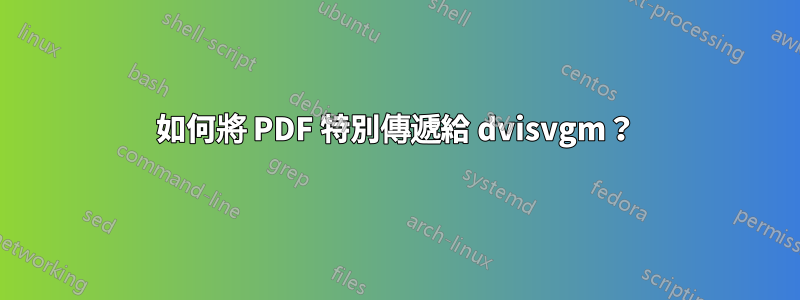
來自 dvisvgm 文件:
SUPPORTED SPECIALS
dvisvgm supports several special commands that enrich the DVI command set with additional
instructions for features, like color, graphics, and hyperlinks. The term special command,
or just special, originates from the TeX command \special{...} which does almost nothing.
[...]
dvisvgm
dvisvgm offers its own small set of specials. The following list gives a brief
overview.
dvisvgm:raw text
Adds an arbitrary sequence of XML nodes to the page section of the SVG document.
dvisvgm checks syntax and proper nesting of the inserted elements but does not
perform any validation, thus the user has to ensure that the resulting SVG is
still valid. Opening and closing tags may be distributed among different raw
specials. The tags themselves can also be split but must be continued with the
immediately following raw special. Both syntactically incorrect and wrongly nested
tags lead to error messages. Parameter text may also contain the expressions {?x},
{?y}, {?color}, and {?matrix} that expand to the current x or y coordinate, the
current color, and current transformation matrix, respectively. Character sequence
{?nl} expands to a newline character. Finally, constructions of the form {?(expr)}
enable the evaluation of mathematical expressions which may consist of basic
arithmetic operations including modulo. Like above, the variables x and y
represent the current coordinates. Example: {?(-10*(x+2y)-5)}.
如果我將以下 TeX 檔案編譯為 DVI,然後使用 dvisvgm 將其轉換為 SVG:
\pdfoutput=0
\pdfcompresslevel=0
\pdfobjcompresslevel=0
\documentclass{article}
\usepackage[active, tightpage]{preview}
\usepackage{tikz}
\pagenumbering{gobble}
\begin{document}
\begin{preview}
\special{dvisvgm:raw <g id='abc'>}
\begin{tikzpicture}
\draw (0,0) circle (1);
\end{tikzpicture}
\special{dvisvgm:raw </g>}
\end{preview}
\end{document}
→
dvisvgm --output=main.svg main.dvi
那麼 SVG 輸出為:
<?xml version='1.0' encoding='UTF-8'?>
<!-- This file was generated by dvisvgm 3.1.2 -->
<svg version='1.1' xmlns='http://www.w3.org/2000/svg' xmlns:xlink='http://www.w3.org/1999/xlink' width='57.0899pt' height='57.0899pt' viewBox='-.00005 -57.08985 57.0899 57.0899'>
<g id='page1'>
<g id='abc'>
<path d='M56.8906-28.546875C56.8906-44.2031 44.2031-56.8906 28.546875-56.8906C12.8906-56.8906 .1992-44.2031 .1992-28.546875C.1992-12.8906 12.8906-.1992 28.546875-.1992C44.2031-.1992 56.8906-12.8906 56.8906-28.546875Z' stroke='#000' fill='none' stroke-width='.3985'/>
</g>
</g>
</svg>
重要的部分是指定的群組abc包含在輸出中。
現在我嘗試做同樣的事情,但是透過 PDF:
\pdfoutput=1
\pdfcompresslevel=0
\pdfobjcompresslevel=0
\documentclass{article}
\usepackage[active, tightpage]{preview}
\usepackage{tikz}
\pagenumbering{gobble}
\begin{document}
\begin{preview}
\special{pdf:dvisvgm:raw <g id='abc'>}
\begin{tikzpicture}
\draw (0,0) circle (1);
\end{tikzpicture}
\special{pdf:dvisvgm:raw </g>}
\end{preview}
\end{document}
特價商品如預期包含在 PDF 中:
%PDF-1.5
%ÐÔÅØ
6 0 obj
<<
/Length 392
>>
stream
1 0 0 1 0.5 57.591 cm
dvisvgm:raw <g id='abc'>
1 0 0 1 28.546 -28.545 cm
q
0 G
0 g
0.3985 w
q
0.0 0.0 m
然後我將 SVG 轉換為 PDF:
dvisvgm --pdf --output=main.svg main.pdf
但 SVG 不包含所需的標籤。
問題:是否可以進行 TeX → PDF → SVG 編譯,並在 TeX 原始碼中指定要插入到最終 SVG 檔案中的原始 SVG 標籤(就像我在 TeX → DVI → SVG 編譯中所做的那樣)?


